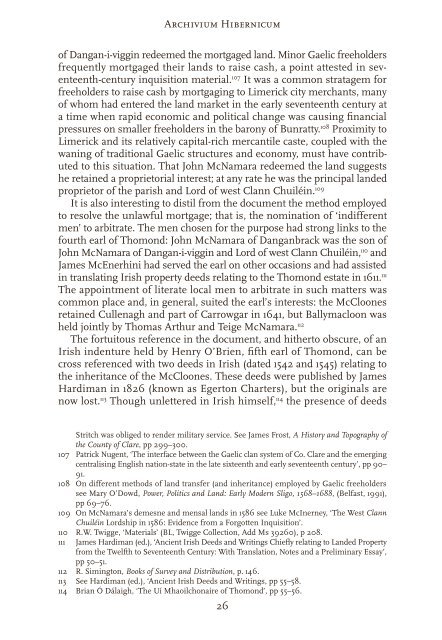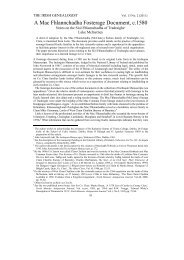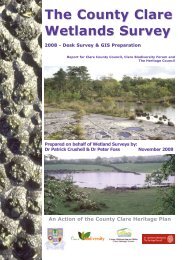Documents from the Thomond Papers at Petworth House Archive1 ...
Documents from the Thomond Papers at Petworth House Archive1 ...
Documents from the Thomond Papers at Petworth House Archive1 ...
Create successful ePaper yourself
Turn your PDF publications into a flip-book with our unique Google optimized e-Paper software.
Archivium Hibernicum<br />
of Dangan-i-viggin redeemed <strong>the</strong> mortgaged land. Minor Gaelic freeholders<br />
frequently mortgaged <strong>the</strong>ir lands to raise cash, a point <strong>at</strong>tested in seventeenth-century<br />
inquisition m<strong>at</strong>erial. 107 It was a common str<strong>at</strong>agem for<br />
freeholders to raise cash by mortgaging to Limerick city merchants, many<br />
of whom had entered <strong>the</strong> land market in <strong>the</strong> early seventeenth century <strong>at</strong><br />
a time when rapid economic and political change was causing financial<br />
pressures on smaller freeholders in <strong>the</strong> barony of Bunr<strong>at</strong>ty. 108 Proximity to<br />
Limerick and its rel<strong>at</strong>ively capital-rich mercantile caste, coupled with <strong>the</strong><br />
waning of traditional Gaelic structures and economy, must have contributed<br />
to this situ<strong>at</strong>ion. Th<strong>at</strong> John McNamara redeemed <strong>the</strong> land suggests<br />
he retained a proprietorial interest; <strong>at</strong> any r<strong>at</strong>e he was <strong>the</strong> principal landed<br />
proprietor of <strong>the</strong> parish and Lord of west Clann Chuiléin. 109<br />
It is also interesting to distil <strong>from</strong> <strong>the</strong> document <strong>the</strong> method employed<br />
to resolve <strong>the</strong> unlawful mortgage; th<strong>at</strong> is, <strong>the</strong> nomin<strong>at</strong>ion of ‘indifferent<br />
men’ to arbitr<strong>at</strong>e. The men chosen for <strong>the</strong> purpose had strong links to <strong>the</strong><br />
fourth earl of <strong>Thomond</strong>: John McNamara of Danganbrack was <strong>the</strong> son of<br />
John McNamara of Dangan-i-viggin and Lord of west Clann Chuiléin, 110 and<br />
James McEnerhini had served <strong>the</strong> earl on o<strong>the</strong>r occasions and had assisted<br />
in transl<strong>at</strong>ing Irish property deeds rel<strong>at</strong>ing to <strong>the</strong> <strong>Thomond</strong> est<strong>at</strong>e in 1611. 111<br />
The appointment of liter<strong>at</strong>e local men to arbitr<strong>at</strong>e in such m<strong>at</strong>ters was<br />
common place and, in general, suited <strong>the</strong> earl’s interests: <strong>the</strong> McCloones<br />
retained Cullenagh and part of Carrowgar in 1641, but Ballymacloon was<br />
held jointly by Thomas Arthur and Teige McNamara. 112<br />
The fortuitous reference in <strong>the</strong> document, and hi<strong>the</strong>rto obscure, of an<br />
Irish indenture held by Henry O’Brien, fifth earl of <strong>Thomond</strong>, can be<br />
cross referenced with two deeds in Irish (d<strong>at</strong>ed 1542 and 1545) rel<strong>at</strong>ing to<br />
<strong>the</strong> inheritance of <strong>the</strong> McCloones. These deeds were published by James<br />
Hardiman in 1826 (known as Egerton Charters), but <strong>the</strong> originals are<br />
now lost. 113 Though unlettered in Irish himself, 114 <strong>the</strong> presence of deeds<br />
Stritch was obliged to render military service. See James Frost, A History and Topography of<br />
<strong>the</strong> County of Clare, pp 299–300.<br />
107 P<strong>at</strong>rick Nugent, ‘The interface between <strong>the</strong> Gaelic clan system of Co. Clare and <strong>the</strong> emerging<br />
centralising English n<strong>at</strong>ion-st<strong>at</strong>e in <strong>the</strong> l<strong>at</strong>e sixteenth and early seventeenth century’, pp 90–<br />
91.<br />
108 On different methods of land transfer (and inheritance) employed by Gaelic freeholders<br />
see Mary O’Dowd, Power, Politics and Land: Early Modern Sligo, 1568–1688, (Belfast, 1991),<br />
pp 69–76.<br />
109 On McNamara’s demesne and mensal lands in 1586 see Luke McInerney, ‘The West Clann<br />
Chuiléin Lordship in 1586: Evidence <strong>from</strong> a Forgotten Inquisition’.<br />
110 R.W. Twigge, ‘M<strong>at</strong>erials’ (BL, Twigge Collection, Add Ms 39260), p 208.<br />
111 James Hardiman (ed.), ‘Ancient Irish Deeds and Writings Chiefly rel<strong>at</strong>ing to Landed Property<br />
<strong>from</strong> <strong>the</strong> Twelfth to Seventeenth Century: With Transl<strong>at</strong>ion, Notes and a Preliminary Essay’,<br />
pp 50–51.<br />
112 R. Simington, Books of Survey and Distribution, p. 146.<br />
113 See Hardiman (ed.), ‘Ancient Irish Deeds and Writings, pp 55–58.<br />
114 Brian Ó Dálaigh, ‘The Uí Mhaoilchonaire of <strong>Thomond</strong>’, pp 55–56.<br />
26

















